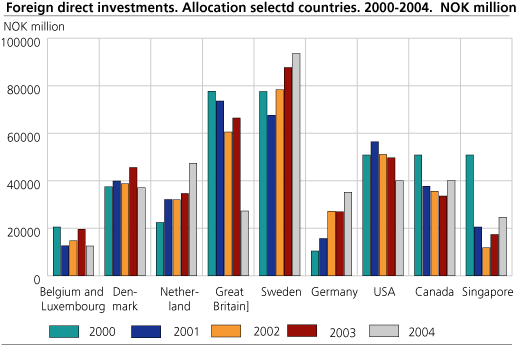Content
Published:
This is an archived release.
Decrease in foreign direct investment
At the end of 2004, Norway's stock of foreign direct investment (FDI) amounted to NOK 543 billion, compared with NOK 551 billion at the end of 2003. The stocks of investments toward the European Union are reduced, while the share of foreign investment directed at Asia and Africa has increased.
The stock of direct investment abroad by the end of 2004 is influenced by disinvestments through sale of several large companies throughout the year. Large company groups have established centralized settlement units abroad, and major internal rearrangement of claims and debt in these groups, have caused a considerable reduction in claims in 2004. Due to these factors, there was reduction in total direct investment, i.e. both equity and loans.
The importance of Sweden
61 per cent of the outward direct investment (FDI) was located in European countries, down from 65 per cent at the end of 2003. The reduction is mainly related to a major management sell-out in Great Britain in 2004. Sweden is, as in previous years, the most important destination for Norwegian foreign investment with 17 per cent. The stock of FDI in the USA and Denmark decreased as a consequence of sell-outs. As investment in Canada has increased, the stock of FDI is at the same level as in the USA. Countries in Africa and Asia are increasingly important and Asia counted for 10 percent of the invested capital by the end of 2004.
From 2004 the European Union is specified as both EU-15, which includes the member states as of 1995, and EU-25, which includes the new central- and eastern members states. 54 percent of FDI is directed at EU-15, while the new members play a less important role with only 3 percent of the FDI.
Manufacturing and mining investments still high
Investors within the manufacturing and mining industries make 42 per cent of direct investment abroad. This is a reduction from 2003 when their investment amounted to 46 per cent. There was also a reduction in investment from investors within financial intermediation and insurance, while businesses within oil and gas exploration increased their investment.
The return on foreign direct investment is defined as the investor's share of retained earnings, plus dividend paid and net interest income. Norwegian investors return on direct investment is amounted to NOK 29 billion by the end of 2004.
About the figures
The figures presented are based on data from the Directorate of Taxes. The survey covers foreign enterprises in which a Norwegian investor has direct ownership of 10 per cent or more of the equity, or indirect ownership of 50 per cent or more. The FDI statistics is a continuation of Norges Bank's statistics from 1988.
The figures represent the book values of the foreign objects of investment, which can be very different from the market values. Invested capital in directly and indirectly owned companies is aggregated. This leads to higher estimates of invested capital abroad compared with the use of consolidated accounts for the directly owned companies.
See also: http://www.norges-bank.no/stat/historiske_data/en/invnorskiutl/
Tables:
- Table 1 Foreign direct investments. 1998-2004. Total. NOK million. (Corrected 10 October 2006)
- Table 2 Foreign direct investments. Geographical distribution. 1998-2004. Total. NOK million
- Table 3 Foreign direct investments. Industrial distribution. 1998-2004. Total. NOK million
- Table 4 Return on outward direct investments. 1998-2004. Total. NOK million
The statistics is published with Foreign direct investment.
Contact
-
Statistics Norway's Information Centre
E-mail: informasjon@ssb.no
tel.: (+47) 21 09 46 42

